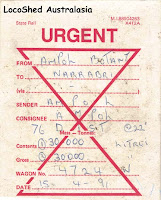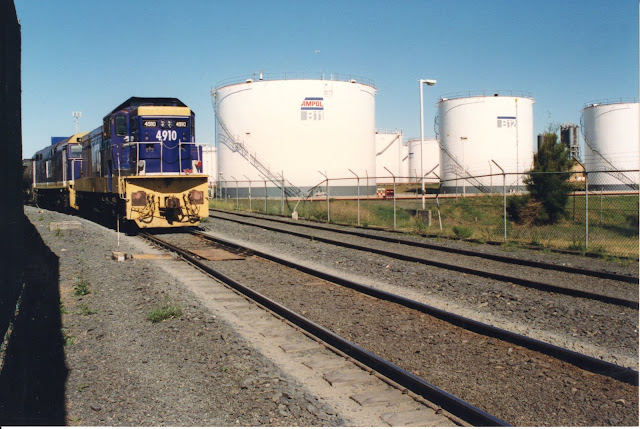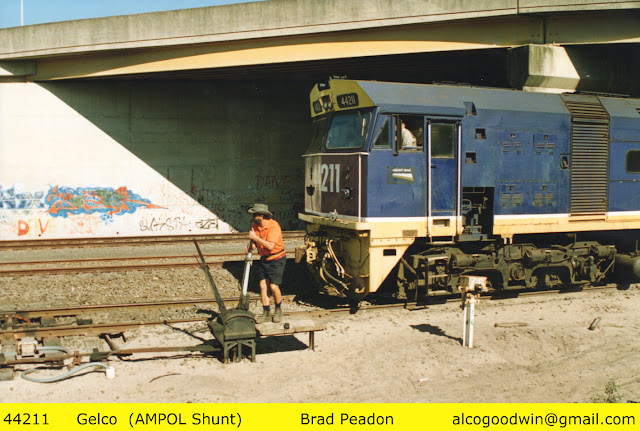Article: Brad Peadon
This article was originally written for the former 'The Smutter' ezine, but only ever saw the first part published. I have always felt that this branch had huge modelling potential at a rather cheap cost, it is also one for those who prefer collecting more model locomotives than rollingstock.
I first put this three-part article together back in July 2019, coinciding with a plan to finally start a layout based on the line.
I have decided to sit down, fix the horrid design, and add more content.
As always, I would very much welcome any further information and photos related to the branch.
You can also find much more Botany line content on our Facebook forum.
Yellow: Former ICI branch which, while closing decades earlier, is still easier to make out when on location.
--------------------------------------------------------------------------------
When we first dream of building our own model railway empire - whether we’re young or well-advanced in years - many of us imagine cramming as much track as humanly possible onto the available board space.
This often leaves little room for trees, structures, or even the vaguest hint of reality. The result? Trains endlessly looping around, seemingly without rhyme or reason. While this might be entertaining for a while, the novelty tends to wear off quickly. Before long, you'll find yourself drifting back to internet forums, ready to stir up trouble again.
A wise - though delightfully cantankerous - modeller from the far-flung reaches of Wagga Wagga once shared a gem of advice with me: “More is not necessarily better.”
Now, I’ll admit, his actual words were probably far less polite (and unprintable), but the sentiment stuck with me. Painful as it is to acknowledge, this truth has shaped many of the changes I’ve made to my former Tinlow layout over the years.
Long before this nugget of wisdom graced my ears, though, I had my sights set on a layout inspired by the now-defunct AMPOL branch line. This short stretch of track ran from the Gelco yard at Botany (Sydney) to the now obliterated AMPOL fuel terminal. With its minimal infrastructure and operational quirks, it struck me as the perfect layout for those who enjoy a surplus of locomotives with just a smattering of rollingstock to shuffle about.
Let’s kick off this epic journey with some photos of the line during its twilight years. Stay tuned, because in the coming days, the thrilling AMPOL saga continues!
AMPOL Terminal during refurbishment with the sidings having been relaid.
Photo: Brad Peadon
Following refurbishment of the sidings in the 90s.
To the best of my knowledge, which really is not that great, the terminal has never used a rail-based shunter. This beast would be seen shunting the empties/loaded tankers around the small yard there, thus alleviating the need for a permanent shunting loco.
Photo: Brad Peadon
4910 44211 shunt the AMPOL terminal. Baker Street level crossing in the foreground.
Photo: David Xuereb
Not much effort needed for 4827 to push NTAF4037 fron Gelco to the terminal.
Ocean Street - Photo: David Xuereb
Ocean Street - Photo: David Xuereb
48100 pushing tankers over Ocean Street.
Photo: David Xuereb
4851 about to pull out a rake of loaded tankers.
Photo: David Xuereb
4910 44211 at the AMPOL Terminal.
Both Photos: David Xuereb
44212 shunting the loading bays while the road-based shunter can be seen in the sidings to the left. There were two sidings curving behind that green wall (see part 3)
Photo: David Xuereb
Photo: David Xuereb
Waiting to cross Ocean Street.
Photo: David Xuereb
Shunter Steve protects Baker Street as 44212 leads loaded tankers
out of the terminal.
Photo: Brad Peadon
Changing the points to allow 44211 access to the branch.
Photo: Brad Peadon
Thanks to former local, and lineside companion at Botany for many years, David Xuereb, for use of your photos. Many of which appear in this series.
David lived somewhat closer to the branch than I, so had a lot more opportunity to photograph the daily coming and going.
David lived somewhat closer to the branch than I, so had a lot more opportunity to photograph the daily coming and going.
Hundreds more photos are gradually appearing on our Botany Line research forum.
Photo: Brad Peadon
-------------------------------------------------------------------------------
In part 2 we take a walk along the branch and photograph the line-side structures.
-------------------------------------------------------------------------------
In part 2 we take a walk along the branch and photograph the line-side structures.
------------------------------------------------------------------------------
-------------------------------------------------------------

-----------------------------------------------------------------------
Thanks to Bradly Coulter, David Xuereb, and the Botany Historical Trust (Eastgardens Library).
Smithston Design & Graphics
Wikipedia
The Story Of The Sydnenham To Botany Railway by Neville Pollard.
Check our new Linktree site above for piles of dreary transport entertainment.
-----------------------------------------------------------------------





































































